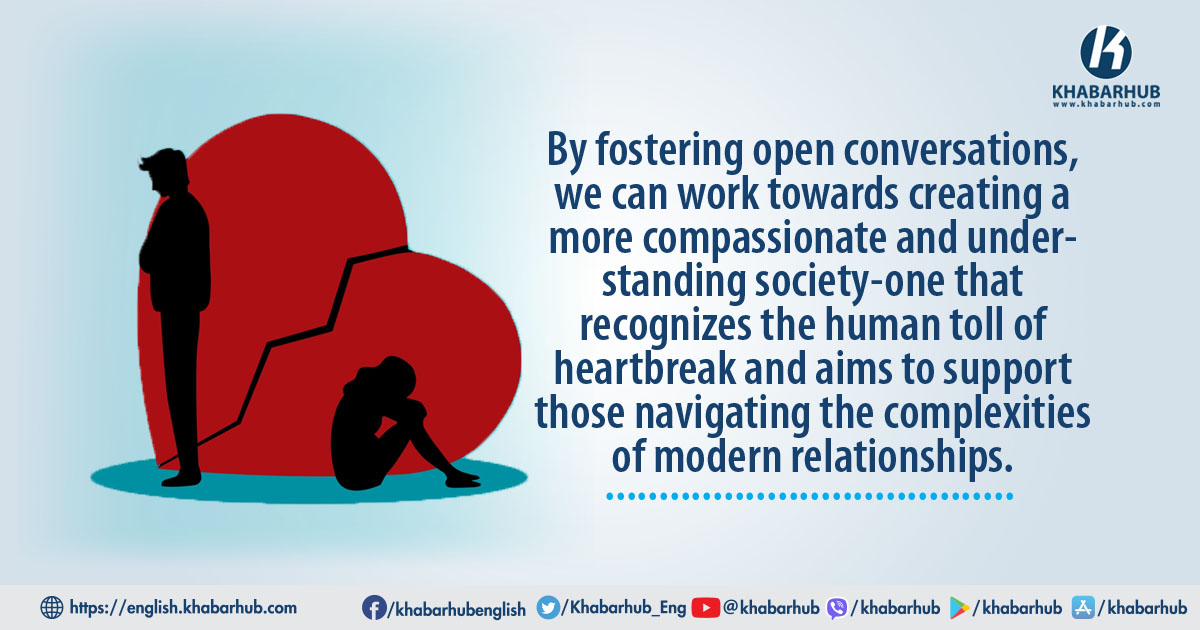KATHMANDU: In recent years, the haunting specter of heartbreak has taken a devastating toll on young lives, shining a light on the profound impact of failed relationships.
Tragically, these stories underscore the dire consequences that can unfold when emotional turmoil intertwines with societal expectations.
Consider the heart-wrenching case of Yuvraj Poudel, a 21-year-old journalist from Radio Deshantar, who met a tragic end in his office.
Poudel’s final Facebook post revealed a painful narrative of betrayal, as he cited a broken relationship as the catalyst for his decision to take his own life.
Similarly, in Nawalpur, an 18-year-old youth’s life ended prematurely, triggered by the disappearance of his wife-in-law.
Their love, kindled through social media, faced opposition from both families due to economic disparities.
Despite their efforts to forge a union against familial objections, their marriage proved short-lived.
A disheartening pattern emerges when societal norms clash with personal choices.
The episode in Jhapa, where inter-caste love led to strife, further illustrates the challenges faced by couples navigating societal expectations.
The relentless pursuit of love, often met with resistance, has dire consequences.
These incidents highlight a pressing need for society to engage in a thoughtful debate about the intersections of mental health, societal expectations, and relationships.
Suicide, a complex issue, manifests for a myriad of reasons. Heartbreak, especially stemming from infidelity, serves as a tragic catalyst for both genders.
A prominent psychiatrist asserts that the recent surge in breakups requires collective introspection.
By fostering open conversations, we can work towards creating a more compassionate and understanding society—one that recognizes the human toll of heartbreak and aims to support those navigating the complexities of modern relationships.
It’s time to break the silence and initiate a dialogue that could potentially save lives.
The young man earnestly proposed to the girl, emphasizing the impermanence of their clandestine relationship.
He implored her to consider marriage as the only viable solution, highlighting the undeniable connection they shared.
Despite his sincere counsel to elope, the girl, burdened by the fear of her husband discovering her absence and her physical limitations, hesitated.
One fateful night, the boy insisted on an escape plan during a lengthy phone conversation.
The couple meticulously strategized their getaway. The following day, the boy courageously leapt into action, arriving at the agreed-upon location.
However, the girl, torn by conflicting emotions, ultimately reneged on their agreement, citing concerns for her child.
In a desperate attempt to hold on, the boy clutched the girl’s hand, urging her to reconsider.
Yet, she managed to break free and fled home. A sudden change of heart weighed heavily on her.
Dejected, the disappointed boy returned home to an empty house, sending his sister on an errand for mobile recharge.
Tragically, in the solitude of his despair, he fastened a shawl to the house’s ceiling and took his own life before his sister returned.
Psychiatrist and researcher Dr. Rishabh Koirala sheds light on a global perspective, revealing that more women attempt suicide than men.
The haunting question persists: Why do individuals resort to such drastic measures?
Suicide, a complex issue, manifests for a myriad of reasons. Heartbreak, especially stemming from infidelity, serves as a tragic catalyst for both genders.
However, statistics paint a somber picture, indicating that boys are more prone to succumb to the depths of despair and take their own lives.
The nuanced factors contributing to this alarming trend beckon us to delve into a deeper understanding and advocate for mental health support to prevent such tragic outcomes.
The revelation of the three-year suicide statistics at the police headquarters is deeply alarming, depicting a grim reality of 18,703 lives lost.
DIG Kuber Kadayat, the spokesperson of Nepal Police, expresses his concern, emphasizing the gravity of the situation for the country.
DIG Kadayat highlights a distressing trend within the younger generation, attributing suicides to the overwhelming desire to prove or demonstrate love.
He underscores the urgent need for concerned agencies to address this issue seriously.
The recognition of mental health as a primary catalyst for such outcomes underscores the urgency for comprehensive intervention strategies to address this pressing societal concern.
According to police statistics, the predominant method of suicide is hanging.
Psychiatrist and researcher Dr. Rishabh Koirala sheds light on a global perspective, revealing that more women attempt suicide than men.
He notes that women often opt for less lethal methods, while men, employing stronger means, unfortunately, have a lower likelihood of survival.
Dr. Koirala explains that the higher number of male suicides is due to the success of their attempts, pointing to a higher possibility of suicide among individuals with personality disorders.
He introduces the concept of the ‘cocaine mechanism,’ where some individuals struggle to cope with even minor issues, leading them to a point of despair and a desire to end their lives.
This can manifest as a sense of detachment from family or society, categorized as a personality disorder.
The psychiatrist emphasizes that mental health plays a pivotal role in suicide cases, suggesting that around 80 percent of suicides stem from individuals grappling with mental health issues such as depression, bipolar disorder, and psychosis symptoms.
Adding another layer to the complex issue, Dr. Koirala identifies social factors as contributors to the rise in suicides.
Struggles in maintaining personal honor, financial stability within families, and relationships all intertwine to create a precarious situation.
He stated that when these foundational aspects of life are mismanaged, individuals may resort to the tragic choice of suicide.
Determining whether someone encouraged suicide poses considerable challenges, with advocate Giri asserting the difficulty in establishing evidence or reasons for such encouragement.
The recognition of mental health as a primary catalyst for such outcomes underscores the urgency for comprehensive intervention strategies to address this pressing societal concern.
The essence of life is intricately tied to an individual’s personality, and instances of suicide often arise from relationship breakdowns, as emphasized by Koirala.
Reflecting on breakup incidents affecting 95% of people, he challenges the notion that suicide is warranted in such circumstances, urging individuals to redirect their focus towards personal goals and the potential for future happiness.
Koirala emphasizes the rarity of marrying the person one falls in love with, stressing the enduring value of life despite romantic disappointments.
Social factors also play a pivotal role, according to Koirala, who points out that issues such as loneliness exacerbated by the Covid pandemic and worsening economic conditions contribute to the escalation of mental health problems.
He questions the societal discourse on discouraging suicide, probing whether communities are genuinely supporting one another or inadvertently perpetuating negative stereotypes about weakness and pessimism.
Highlighting the critical roles of family and society in suicide prevention, Koirala advocates for a multidimensional approach, emphasizing the need to address mental health as a disease and evaluate the state’s efforts in creating awareness.
He raises pertinent questions about the accessibility of services for those exhibiting unhealthy behaviors or experiencing mental imbalances, especially in remote areas.
The case involving journalist Rabi Lamichhane, accused by Salikram Pudasaini of contributing to his decision to commit suicide, illustrates the complexities of interpreting evidence.
Drawing an analogy to aviation safety, Koirala calls for a goal of 100% prevention rather than mere reduction of suicides.
In a legal perspective, advocate Bikash Giri discusses the challenges in proving that a second party was ‘forced to commit suicide.’
He notes the nascent efforts in Nepal concerning the Suicide Prevention Code and anticipates the legal landscape evolving, emphasizing the need for a comprehensive approach to address such cases effectively.
Determining whether someone encouraged suicide poses considerable challenges, with advocate Giri asserting the difficulty in establishing evidence or reasons for such encouragement.
While acknowledging that individuals may face judgment, Giri notes the low likelihood of most cases resulting in convictions.
Giri reflects on his experience with suicide abetment cases, revealing that, to date, none have reached a definitive resolution.
Despite initial detention and subsequent release on bail, the establishment of a crime remains elusive.
From a legal standpoint, suicide is recognized as an aggravated crime, but Giri underscores the societal perspective that attributes suicide to an individual’s own actions rather than external influence.
Confirming the involvement of another party in the act of suicide proves challenging.
As per sub-section 1 of this section, individuals found guilty of such abetment may face imprisonment for a period of 5 years along with a fine of up to 50,000 rupees.
Contrary to common belief, instances exist where individuals have faced legal consequences for actions leading to suicide.
Notably, Sudhan Sangraula found himself in jail after the self-immolation of Pushpa Neupane, who cited a broken engagement as the motive for her tragic act.
The case involving journalist Rabi Lamichhane, accused by Salikram Pudasaini of contributing to his decision to commit suicide, illustrates the complexities of interpreting evidence.
The court, in this instance, did not accept a video as conclusive proof, highlighting the difficulties in establishing a causal link between alleged encouragement and the act of suicide.
While legally considered a criminal offense, suicide’s unique nature presents challenges in prosecution.
The law acknowledges suicide as a crime, but when the individual dies, the crime extinguishes with them.
However, a legal principle allows for the prosecution of those attempting suicide, emphasizing the complex intersection of legal and societal perspectives on this sensitive matter.
Incitement to suicide is now addressed under the new Civil Code, which replaced the Civil Act and became effective on August 17, 2018.
Section 185 of Clause 12 in the Code explicitly outlines provisions for cases involving abetment to commit suicide.
As per sub-section 1 of this section, individuals found guilty of such abetment may face imprisonment for a period of 5 years along with a fine of up to 50,000 rupees.









Comment